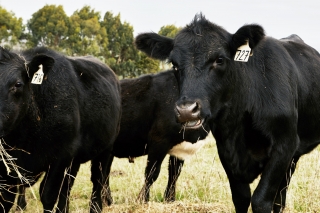 As growers continue to innovate new methods of sustainable farming, some have committed swathes of land to be reclaimed by native vegetation. Called regenerative farming, this technique is great for local wildlife, biodiversity, and capturing carbon in the environment. It also helps provide more humane conditions for farmed animals. Australian cattle rancher Paul Crock implemented regenerative farming with the goal of creating a truly sustainable food system.
As growers continue to innovate new methods of sustainable farming, some have committed swathes of land to be reclaimed by native vegetation. Called regenerative farming, this technique is great for local wildlife, biodiversity, and capturing carbon in the environment. It also helps provide more humane conditions for farmed animals. Australian cattle rancher Paul Crock implemented regenerative farming with the goal of creating a truly sustainable food system.
Crock raises grass-fed cows in the Gippsland region of southern Australia, and his property is home to about 120 Angus cattle at any given time as well as roughly 50 lambs that assist in weed control. He said over 20 percent of his 400 acres is dedicated to regenerative land, and he has planted over 75,000 trees in the last 20 years. The rancher cares for each cow for about two years before they are sent to be processed and distributed, and most Australian grass-fed beef is exported to the U.S.
“You can have a quality grass-fed product and you can have a quality grain-fed product,” Crock said, “the seasonality and the variances in climate is what determines the quality of the meat. Where we are, we've got beautiful, mild summers and mild winters, so we can produce really good cattle entirely on grass that will be of high eating quality.”
Producing high-quality grass-fed beef can be a challenge in the U.S. because harsh winters mean cattle must be kept indoors and fed grain. Crock said there are dual benefits to planting all those trees. There are the obvious soil and land benefits but also a tree line effectively protects his livestock and improves animal well-being by providing shade during summers and a windbreak against cold gusts.
Crock said beef from his cows contains vitamin B carotenes found in grass, which translates to a beefier flavor and richer color. The fat in grass-fed beef is also packed with omega 3 fatty acids, making it creamier and healthier for most diets. Intermuscular fat called marbling cooks inside beef and gives the meat flavor and tenderness.
To achieve the highest quality beef, cattle are bred for marbling and kept as calm and stress-free as possible. The rancher never uses growth hormones on his livestock and only uses antibiotics if a cow is sick. Crock said he raises animals as nature intended, and he forms a bond with his cows to make life more pleasant for grower and cattle alike.
 “We've worked for months to bring this piece of meat to your table and you've got it for 10 minutes,” Crock said. “And in those 10 minutes, our months of work comes down to how well that person prepares that meal. So, handle it with care.”
“We've worked for months to bring this piece of meat to your table and you've got it for 10 minutes,” Crock said. “And in those 10 minutes, our months of work comes down to how well that person prepares that meal. So, handle it with care.”
Regenerative farming also makes financial sense, especially because weather plays a huge role in a grower’s success. During one particularly brutal cold snap, Crock said he was able to move his flock of lambs — around 500 at the time — to the tree line. The rancher lost about 30 lambs that day while his neighbors lost hundreds.
Crock holds a degree in agriculture science and purchased his land with a goal of practicing sustainable agriculture. He said his interest in sustainability turned into a mission to offset carbon emissions and has and has become a way of life.

“Cattle play a very important role in processing the nutrient cycle,” Crock said. The nutrient cycle is a system where energy and matter are transferred between living organisms and non-living parts of the environment. “A lot of people think cattle produce a lot of carbon emissions and cattle are part of the problem, whereas the type of cattle we have and the way we run the cattle in a grass-fed environment makes them part of the cycle.”
Crock is not alone in his quest for a more eco- and animal-friendly food system. The entire Australian industry has set the ambitious target to be carbon neutral by 2030 – a goal based in science and achievable with the kinds of methods and practices that Crock is using today. Australia is over halfway to achieving this target, having reduced emissions by 56 percent already.
